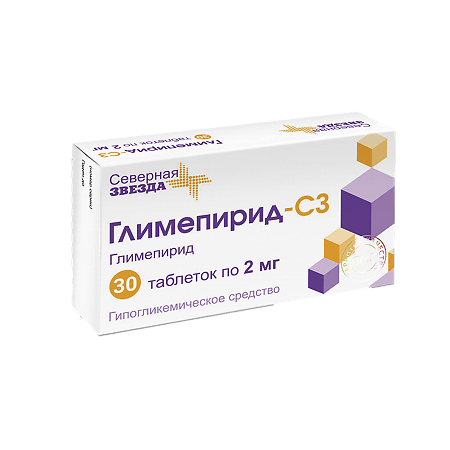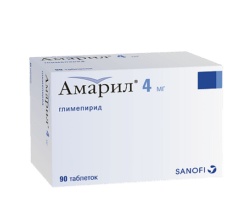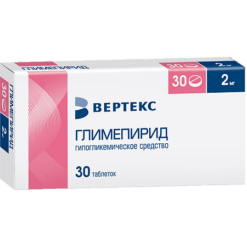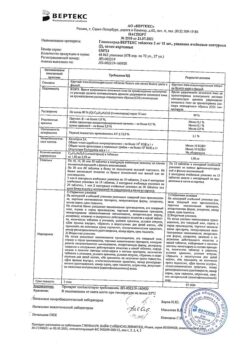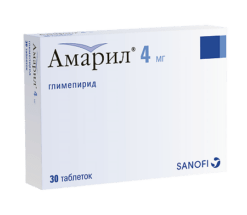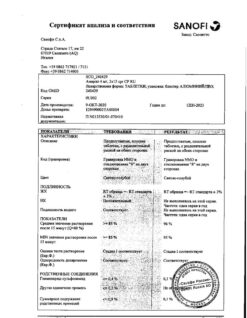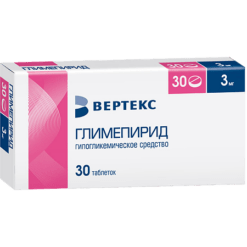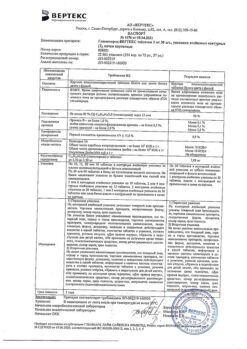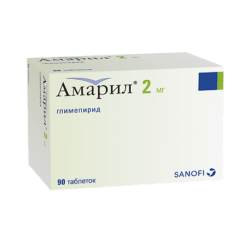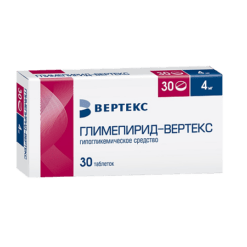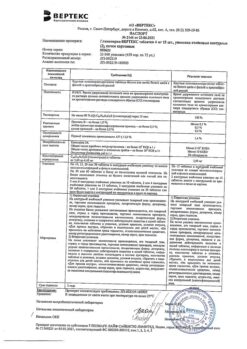No products in the cart.
Glimepiride-SZ, tablets 2 mg 30 pcs
€6.25 €5.47
Description
Pharmacodynamics
Glimepiride reduces blood glucose concentration mainly due to stimulation of insulin release from pancreatic beta-cells. Its effect is mainly due to an improvement in the ability of pancreatic beta cells to respond to physiological glucose stimulation. Compared to glibenclamide, taking low doses of glimepiride causes the release of less insulin while achieving approximately the same decrease in blood glucose concentrations. This fact is evidence in favor of the presence of extrapancreatic hypoglycemic effects of glimepiride (increased tissue sensitivity to insulin and insulinomimetic effect).
Insulin secretion
Like all other sulfonylurea derivatives, glimepiride regulates insulin secretion through interaction with ATP-sensitive potassium channels on beta cell membranes. Unlike other sulfonylurea derivatives, glimepiride selectively binds to a protein with a molecular weight of 65 kilodaltons (kDa) located in the membranes of pancreatic beta cells. This interaction of glimepiride with its binding protein regulates the opening or closing of ATP-sensitive potassium channels.
Glimepiride closes potassium channels. This causes depolarization of beta cells and leads to the opening of voltage-sensitive calcium channels and the entry of calcium into the cell. As a result, increased intracellular calcium concentration activates insulin secretion by exocytosis.
Glimepiride is much faster and therefore more likely to bind to and be released from its binding protein than glibenclamide. It is assumed that this property of glimepiride’s high rate of exchange with its binding protein accounts for its pronounced glucose sensitizing effect on beta cells and its protection against desensitization and premature depletion.
The effect of increasing tissue sensitivity to insulin
Glimepiride increases the effects of insulin on glucose uptake by peripheral tissues.
Insulinomimetic effects
Glimepiride has effects similar to those of insulin on peripheral tissue glucose uptake and hepatic glucose output. Glucose uptake by peripheral tissues is by transport inside muscle cells and adipocytes. Glimepiride directly increases the number of glucose transporting molecules in the plasma membranes of muscle cells and adipocytes. Increased intracellular glucose entry leads to activation of glycosylphosphatidylinositol-specific phospholipase C. As a result, intracellular calcium concentration decreases, causing a decrease in protein kinase A activity, which in turn leads to stimulation of glucose metabolism.
Glimepiride inhibits glucose output from the liver by increasing the concentration of fructose-2,6-bisphosphate, which inhibits gluconeogenesis.
The effect on platelet aggregation
Glimepiride reduces platelet aggregation in vitro and in vivo. This effect appears to be due to selective inhibition of cyclooxygenase, which is responsible for the formation of thromboxane A, an important endogenous factor of platelet aggregation.
Antiatherogenic action of the drug
Glimepiride promotes normalization of lipids, decreases malonic aldehyde in blood, which leads to a significant decrease in lipid peroxidation. In animals glimepiride leads to a significant reduction of atherosclerotic plaque formation.
The severity of oxidative stress, which is constantly present in patients with type 2 diabetes, is reduced. Glimepiride increases endogenous α-tocopherol, catalase activity, glutathione peroxidase and superoxide dismutase.
Cardiovascular effects
With the ATP-sensitive potassium channels (see above), sulfonylurea derivatives also have effects on the cardiovascular system. Compared with traditional sulfonylurea derivatives, glimepiride has significantly less effect on the cardiovascular system, which may be explained by the specific nature of its interaction with the ATP-sensitive potassium channel protein that binds to it.
In healthy volunteers, the minimum effective dose of glimepiride is 0.6 mg. The effect of glimepiride is dose-dependent and reproducible. Physiological response to physical activity (decreased insulin secretion) is maintained while taking glimepiride.
There is no significant difference in the effect depending on whether the drug was taken 30 min before a meal or immediately before a meal. In patients with diabetes mellitus, sufficient metabolic control can be achieved within 24 h with a single dose of the drug. In a clinical study, 12 of 16 patients with renal insufficiency (creatinine clearance 4 – 79 ml/min) also achieved sufficient metabolic control.
Combination therapy with metformin
In patients with insufficient metabolic control at the maximum dose of glimepiride, combination therapy with glimepiride and metformin may be initiated. Two studies have shown an improvement in metabolic control with combination therapy compared with treatment with each of these drugs alone.
Combination therapy with insulin
In patients with insufficient metabolic control, concomitant insulin therapy may be initiated with maximum doses of glimepiride. According to the results of two studies, this combination achieves the same improvement in metabolic control as insulin alone; however, the combination therapy requires a lower dose of insulin.
Pediatric use
There are insufficient data on the long-term efficacy and safety of the drug in children.
Pharmacokinetics
Absorption
When glimepiride is taken repeatedly at a daily dose of 4 mg, the maximum plasma concentration (Cmax) is reached after approximately 2.5 hours and is 309 ng/ml. There is a linear relationship between the dose and maximum plasma concentration of glimepiride (Cmax), as well as between the dose and the area under the curve “concentration-time” (AUC). When glimepiride is taken orally, its absolute bioavailability is complete. Food intake has no significant effect on absorption, except for a slight slowing of its rate.
Distribution
Highly low volume of distribution (about
8.8 L), approximately equal to that of albumin, high plasma protein binding (more than 99%) and low clearance (about 48 ml/min) are characteristic for glimepiride. Glimepiride penetrates into breast milk and through the placental barrier.
Metabolism
Glimepiride is metabolized in the liver (mainly with the participation of CYP2C9 isoenzyme) to form two metabolites – hydroxylated and carboxylated derivatives, which are found in urine and feces.
After a single oral dose of glimepiride, 58% of the dose is excreted by the kidneys and 35% of the dose is excreted through the intestine. Unchanged glimepiride is not detected in the urine.
The average elimination half-life (T1/2), determined by serum concentrations under repeated drug administration, is approximately 5 – 8 hours. After taking high doses, a slight increase in T1/2 is noted.
The mean T1/2 of hydroxylated and carboxylated glimepiride metabolites is 3 – 5 and 5 – 6 h, respectively.
A comparison of single and multiple (once-daily) glimepiride administration showed no significant differences in pharmacokinetic parameters; there is very low variability between different patients. There is no significant accumulation of the drug.
Pharmacokinetics in special clinical cases
Pharmacokinetic parameters are similar in patients of different sex and age groups. In patients with impaired renal function (with low creatinine clearance) there is a tendency for glimepiride clearance to increase and its average serum concentrations to decrease, which is likely due to faster drug excretion due to its lower protein binding. Thus, there is no additional risk of drug cumulation in this category of patients.
Indications
Indications
Diabetes mellitus type 2 (in monotherapy or as part of combination therapy with metformin or insulin).
Pharmacological effect
Pharmacological effect
Pharmacodynamics
Glimepiride reduces blood glucose concentrations, mainly by stimulating the release of insulin from the beta cells of the pancreas. Its effect is primarily associated with improving the ability of pancreatic beta cells to respond to physiological stimulation with glucose. Compared with glibenclamide, low doses of glimepiride cause the release of less insulin while achieving approximately the same reduction in blood glucose concentrations. This fact indicates that glimepiride has extrapancreatic hypoglycemic effects (increased tissue sensitivity to insulin and insulinomimetic effect).
Insulin secretion
Like all other sulfonylureas, glimepiride regulates insulin secretion through interaction with ATP-sensitive potassium channels on beta cell membranes. Unlike other sulfonylureas, glimepiride selectively binds to a 65 kilodalton (kDa) protein found in the membranes of pancreatic beta cells. This interaction of glimepiride with its binding protein regulates the opening or closing of ATP-sensitive potassium channels.
Glimepiride closes potassium channels. This causes depolarization of beta cells and leads to the opening of voltage-sensitive calcium channels and the entry of calcium into the cell. As a result, an increase in intracellular calcium concentration activates insulin secretion through exocytosis.
Glimepiride binds and is released from the binding protein much faster and, accordingly, more often than glibenclamide. It is assumed that this property of the high rate of exchange of glimepiride with the protein that binds to it determines its pronounced effect of sensitizing beta cells to glucose and protecting them from desensitization and premature exhaustion.
The effect of increasing tissue sensitivity to insulin
Glimepiride enhances the effects of insulin on glucose uptake by peripheral tissues.
Insulinomimetic effect
Glimepiride has effects similar to those of insulin on glucose uptake into peripheral tissues and glucose output from the liver. Glucose is absorbed by peripheral tissues by transporting it into muscle cells and adipocytes. Glimepiride directly increases the number of glucose transport molecules in the plasma membranes of muscle cells and adipocytes. An increase in the entry of glucose into cells leads to the activation of glycosylphosphatidylinositol-specific phospholipase C. As a result, the intracellular calcium concentration decreases, causing a decrease in the activity of protein kinase A, which in turn leads to stimulation of glucose metabolism.
Glimepiride inhibits the release of glucose from the liver by increasing the concentration of fructose-2,6-bisphosphate, which inhibits gluconeogenesis.
Effect on platelet aggregation
Glimepiride reduces platelet aggregation in vitro and in vivo. This effect appears to be due to selective inhibition of cyclooxygenase, which is responsible for the formation of thromboxane A, an important endogenous platelet aggregation factor.
Antiatherogenic effect of the drug
Glimepiride helps normalize lipid levels, reduces the content of malonaldehyde in the blood, which leads to a significant reduction in lipid peroxidation. In animals, glimepiride leads to a significant reduction in the formation of atherosclerotic plaques.
Reducing the severity of oxidative stress, which is constantly present in patients with type 2 diabetes. Glimepiride increases the content of endogenous α-tocopherol, the activity of catalase, glutathione peroxidase and superoxide dismutase.
Cardiovascular effects
Through ATP-sensitive potassium channels (see above), sulfonylureas also have effects on the cardiovascular system. Compared with traditional sulfonylurea derivatives, glimepiride has a significantly lesser effect on the cardiovascular system, which may be explained by the specific nature of its interaction with the ATP-sensitive potassium channel protein that binds to it.
In healthy volunteers, the minimum effective dose of glimepiride is 0.6 mg. The effect of glimepiride is dose-dependent and reproducible. The physiological response to physical activity (decreased insulin secretion) when taking glimepiride is preserved.
There are no significant differences in the effect depending on whether the drug was taken 30 minutes before a meal or immediately before a meal. In patients with diabetes mellitus, sufficient metabolic control can be achieved within 24 hours with a single dose of the drug. In a clinical study, 12 of 16 patients with renal failure (creatinine clearance 4 – 79 ml/min) also achieved sufficient metabolic control.
Combination therapy with metformin
In patients with insufficient metabolic control when using the maximum dose of glimepiride, combination therapy with glimepiride and metformin may be initiated. Two studies demonstrated improved metabolic control with combination therapy compared with either drug alone.
Combination therapy with insulin
In patients with insufficient metabolic control when using maximum doses of glimepiride, concomitant insulin therapy may be initiated. In two studies, this combination achieved the same improvement in metabolic control as insulin alone; however, combination therapy requires a lower dose of insulin.
Use in children
There is insufficient data on the long-term effectiveness and safety of the drug in children.
Pharmacokinetics
Absorption
With repeated doses of glimepiride in a daily dose of 4 mg, the maximum concentration (Cmax) in the blood plasma is reached after approximately 2.5 hours and is 309 ng/ml. There is a linear relationship between the dose and the maximum plasma concentration of glimepiride (Cmax), as well as between the dose and the area under the concentration-time curve (AUC). When glimepiride is taken orally, its absolute bioavailability is complete. Food intake does not have a significant effect on absorption, except for a slight slowdown in its rate.
Distribution
Glimepiride has a very low volume of distribution (about
8.8 l), approximately equal to the volume of distribution of albumin, high degree of binding to plasma proteins (more than 99%) and low clearance (about 48 ml/min). Glimepiride passes into breast milk and through the placental barrier.
Metabolism
Glimepiride is metabolized in the liver (mainly with the participation of the CYP2C9 isoenzyme) to form two metabolites – hydroxylated and carboxylated derivatives, which are found in urine and feces.
Removal
After a single oral dose of glimepiride, 58% of the dose is excreted by the kidneys and 35% of the dose is excreted through the intestines. Unchanged glimepiride is not detected in urine.
The average half-life (T1/2), determined by serum concentrations in conditions of repeated dosing of the drug, is approximately 5 – 8 hours. After taking high doses, there is a slight increase in T1/2.
The average T1/2 of the hydroxylated and carboxylated metabolites of glimepiride is 3 – 5 and 5 – 6 hours, respectively.
A comparison of single and multiple (once daily) doses of glimepiride did not reveal significant differences in pharmacokinetic parameters; there is very low variability between different patients. There is no significant accumulation of the drug.
Pharmacokinetics in special clinical situations
Pharmacokinetic parameters are similar in patients of different sexes and different age groups. In patients with impaired renal function (low creatinine clearance), there is a tendency for glimepiride clearance to increase and mean serum concentrations to decrease, which is likely due to more rapid elimination of the drug due to its lower protein binding. Thus, in this category of patients there is no additional risk of drug accumulation.
Special instructions
Special instructions
Under specific clinical stress conditions, such as trauma, surgery, infection, and febrile fever, glycemic control may deteriorate in patients with diabetes and they may require temporary switching to insulin therapy to maintain adequate glycemic control.
In the first weeks of treatment, the risk of developing hypoglycemia may increase, and therefore particularly careful monitoring of blood glucose concentrations is required at this time.
Factors that contribute to the risk of developing hypoglycemia include:
– the patient’s reluctance or inability (most often observed in elderly patients) to cooperate with the doctor;
– malnutrition, irregular eating or skipping meals;
– imbalance between physical activity and carbohydrate consumption;
– diet change;
– alcohol consumption, especially in combination with skipping meals;
– severe renal failure;
– severe liver failure (in patients with severe liver failure, transfer to insulin therapy is indicated, at least until glycemic control is achieved);
– overdose of glimepiride;
– some decompensated endocrine disorders that impair carbohydrate metabolism or adrenergic counterregulation in response to hypoglycemia (for example, some dysfunctions of the thyroid gland and anterior pituitary gland, adrenal insufficiency);
– simultaneous use of certain medications (see section “Interaction with other medications”);
– taking glimepiride in the absence of indications for its use.
Treatment with sulfonylurea derivatives, which include glimepiride, can lead to the development of hemolytic anemia, therefore, in patients with glucose-6-phosphate dehydrogenase deficiency, special care should be taken when prescribing glimepiride and it is better to use hypoglycemic agents that are not sulfonylurea derivatives.
In the presence of the above risk factors for the development of hypoglycemia, adjustment of the dose of glimepiride or the entire therapy may be required. This also applies to the occurrence of intercurrent illnesses during treatment or changes in the patients’ lifestyle.
Symptoms of hypoglycemia, which reflect the body’s adrenergic counterregulation in response to hypoglycemia (see section “Side Effects”), may be mild or absent with gradual development of hypoglycemia, in elderly patients, patients with neuropathy of the autonomic nervous system, or patients receiving beta-blockers, clonidine, reserpine and other sympatholytic agents.
Hypoglycemia can be quickly corrected by immediate administration of rapidly digestible carbohydrates (glucose or sucrose).
As with other sulfonylureas, despite initial successful relief of hypoglycemia, hypoglycemia may recur. Therefore, patients should remain under constant monitoring.
Severe hypoglycemia additionally requires immediate treatment and medical supervision, and in some cases, hospitalization of the patient.
During treatment with glimepiride, regular monitoring of liver function and peripheral blood patterns (especially the number of leukocytes and platelets) is required.
Since individual adverse reactions, such as severe hypoglycemia, serious changes in the blood picture, severe allergic reactions, liver failure, can, under certain circumstances, pose a threat to life, in the event of adverse reactions, especially severe ones, the patient should immediately inform the attending physician about them and in no case continue taking the drug without his recommendation.
Active ingredient
Active ingredient
Glimepiride
Composition
Composition
1 tablet contains:
active ingredient:
glimepiride – 2 mg;
excipients: mannitol – 65.2 mg, microcrystalline cellulose (102) – 12.0 mg, sodium carboxymethyl starch – 10.0 mg, povidone K 30 (medium molecular weight polyvinylpyrrolidone) – 1.3 mg, crospovidone (Kollidon CL) – 9.0 mg, magnesium stearate – 0.5 mg.
Pregnancy
Pregnancy
Glimepiride is contraindicated for use in pregnant women. In case of planned pregnancy or if pregnancy occurs, the woman should be transferred to insulin therapy.
Glimepiride passes into breast milk, so it should not be taken during breastfeeding. In this case, it is necessary to switch to insulin therapy or stop breastfeeding.
Contraindications
Contraindications
type 1 diabetes mellitus;
diabetic ketoacidosis, diabetic precoma and coma;
hypersensitivity to glimepiride or to any excipient of the drug, to other sulfonylurea derivatives or to other sulfonamide drugs (risk of developing hypersensitivity reactions);
severe liver failure (lack of experience in clinical use);
severe renal failure, incl. in patients on hemodialysis (lack of experience in clinical use);
pregnancy and breastfeeding;
in children and adolescents under 18 years of age (lack of experience in clinical use).
With caution
In the first weeks of treatment (increased risk of hypoglycemia).
If there are risk factors for the development of hypoglycemia (see section “Special instructions”, adjustment of the dose of glimepiride or the entire therapy may be required).
For intercurrent diseases during treatment or when changing the lifestyle of patients (changing diet and meal times, increasing or decreasing physical activity).
With glucose-6-phosphate dehydrogenase deficiency.
For disorders of absorption of food and drugs in the gastrointestinal tract (GIT) (intestinal obstruction, intestinal paresis).
Side Effects
Side Effects
Adverse reactions when using glimepiride are presented in accordance with the World Health Organization (WHO) classification: very common (≥ 10%), common (≥ 1%, < 10%), uncommon (≥ 0.1%, < 1%), rare (≥ 0.01%, < 0.1%), very rare, including isolated reports
(<0.01%), frequency unknown (it is not possible to determine the frequency from the available data).
Metabolic disorders
Hypoglycemia
As a result of the hypoglycemic effect of the drug Glimepiride-SZ, hypoglycemia may develop, which, as with the use of other sulfonylurea derivatives, can be prolonged.
Symptoms of hypoglycemia are: headache, acute hunger, nausea, vomiting, feeling tired, drowsiness, sleep disturbances, anxiety, aggressiveness, impaired concentration and speed of psychomotor reactions, depression, confusion, speech disorders, aphasia, visual disturbances, tremors, paresis, sensory disturbances, dizziness, loss of self-control, helplessness, delirium, cerebral spasms, somnolence or loss of consciousness up to coma, shallow breathing, bradycardia.
In addition, manifestations of adrenergic counterregulation may occur in response to the development of hypoglycemia, such as: increased sweating, cold and moist skin, increased anxiety, tachycardia, increased blood pressure, angina pectoris, “palpitations” and heart rhythm disturbances.
The clinical presentation of severe hypoglycemia may be similar to a stroke.
Symptoms of hypoglycemia almost always disappear once it is corrected.
Weight gain
When taking glimepiride, like other sulfonylurea derivatives, an increase in body weight is possible (frequency unknown).
Visual disorders
During treatment (especially at the beginning), transient visual disturbances may be observed due to changes in the concentration of glucose in the blood. Their cause is a temporary change in the swelling of the lens, depending on the concentration of glucose in the blood, and due to this change in the refractive index of the lens.
Gastrointestinal disorders
Rarely: nausea, vomiting, feeling of heaviness or fullness in the epigastric region, abdominal pain, diarrhea.
Frequency unknown: dysgeusia (taste disturbances).
Disorders of the liver and biliary tract
In some cases: hepatitis, increased activity of liver enzymes and/or cholestasis and jaundice, which can progress to life-threatening liver failure, but may reverse when the drug is discontinued
Blood and lymphatic system disorders
Rarely: thrombocytopenia.
In some cases: leukopenia, hemolytic anemia, erythrocytopenia,
granulocytopenia, agranulocytosis and pancytopenia.
Frequency unknown: during post-registration use of the drug, cases of severe thrombocytopenia with a platelet count of less than 10,000 / μl and thrombocytopenic purpura have been reported.
Immune system disorders
Rarely: allergic and pseudoallergic reactions, such as itching, urticaria, skin rash. Such reactions are almost always mild, but can develop into severe reactions with shortness of breath, a sharp decrease in blood pressure, which sometimes progress to anaphylactic shock. If symptoms of hives appear, you should consult a doctor immediately. Cross-allergy with other sulfonylurea derivatives, sulfonamides or similar substances is possible.
In some cases: allergic vasculitis.
Skin and subcutaneous tissue disorders
In some cases: photosensitivity.
Frequency unknown: alopecia.
Laboratory and instrumental data
In some cases: hyponatremia.
Interaction
Interaction
Glimepiride is metabolized by the CYP2C9 isoenzyme of the cytochrome P450 system, which should be taken into account when it is used simultaneously with inducers (for example, rifampicin) or inhibitors (for example, fluconazole) of CYP2C9.
Potentiation of the hypoglycemic effect and, in some cases, the associated possible development of hypoglycemia can be observed when combined with one of the following drugs:
insulin and other oral hypoglycemic agents, angiotensin-converting enzyme (ACE) inhibitors, anabolic steroids and male sex hormones, chloramphenicol, coumarin derivatives, cyclophosphamide, fibrates, fluoxetine, ifosfamide, monoamine oxidase inhibitors (MAO), fluconazole, para-aminosalicylic acid, pentoxifylline (high parenteral doses), phenylbutazone, probenecid, quinolones, salicylates, clarithromycin, sulfonamides, tetracyclines.
A weakening of the hypoglycemic effect and an associated increase in blood glucose concentrations can be observed when combined with one of the following drugs:
acetazolamide, barbiturates, glucocorticosteroids, diuretics, epinephrine and other sympathomimetic agents, glucagon, laxatives (with long-term use), nicotinic acid (in high doses), estrogens and progestogens, phenothiazines, phenytoin, rifampicin, iodine-containing thyroid hormones.
H2-histamine receptor blockers, beta-blockers, clonidine and reserpine can both enhance and weaken the hypoglycemic effect of glimepiride.
Under the influence of sympatholytic agents such as beta-blockers, clonidine and reserpine, signs of adrenergic counterregulation in response to hypoglycemia may be reduced or absent.
While taking glimepiride, an increase or decrease in the effect of coumarin derivatives may be observed.
Single or chronic consumption of alcohol can either enhance or weaken the hypoglycemic effect of glimepiride.
Bile acid sequestrants: Colesevelam binds to glimepiride and reduces the absorption of glimepiride from the gastrointestinal tract. When glimepiride is administered at least 4 hours before colesevelam, no interaction is observed. Therefore, glimepiride should be taken at least 4 hours before taking colesevelam.
Overdose
Overdose
Overdose symptoms
Acute overdose, as well as long-term treatment with too high doses of glimepiride, can lead to the development of severe life-threatening hypoglycemia.
Treatment of overdose
As soon as an overdose is detected, you must immediately inform your doctor. Hypoglycemia can almost always be quickly reversed by immediate intake of carbohydrates (glucose or a lump of sugar, sweet fruit juice or tea). In this regard, the patient should always have at least 20 g of glucose (4 lumps of sugar) with him. Sweeteners are ineffective in treating hypoglycemia.
Until the doctor decides that the patient is out of danger, careful medical observation of the patient is necessary. It should be remembered that hypoglycemia may recur after the initial restoration of blood glucose concentrations.
If a patient with diabetes is treated by different doctors (for example, while staying in the hospital after an accident, when sick on the weekend), he must inform them about his disease and previous treatment.
Sometimes it may be necessary to hospitalize the patient, even if only as a precaution. Significant overdose and severe reaction with manifestations such as loss of consciousness or other serious neurological impairment are medical emergencies and require immediate treatment and hospitalization.
If the patient is unconscious, intravenous administration (IV) of a concentrated solution of dextrose (glucose) is necessary (in adults – starting with 40 ml of a 20% solution). As an alternative, subcutaneous or intramuscular administration of glucagon to adults is possible at a dose of 0.5 – 1 mg.
When treating hypoglycemia due to accidental ingestion of the drug in infants or young children, the dose of dextrose administered should be carefully adjusted to avoid the possibility of dangerous hyperglycemia, and dextrose should be administered under close monitoring of blood glucose concentrations.
In case of an overdose of glimepiride, gastric lavage and activated charcoal may be required.
After rapid restoration of blood glucose concentrations, an IV infusion of a dextrose solution at a lower concentration is necessary to prevent the resumption of hypoglycemia. The blood glucose concentration in such patients should be constantly monitored over a 24-hour period. In severe cases with prolonged hypoglycemia, the risk of a decrease in blood glucose concentration to a hypoglycemic level may persist for several days.
Storage conditions
Storage conditions
In a place protected from light, at a temperature not exceeding 25 oC.
Keep out of the reach of children.
Shelf life
Shelf life
3 years. Do not use after the expiration date stated on the package.
Manufacturer
Manufacturer
North Star NAO, Russia
Additional information
| Shelf life | 3 years. Do not use after the expiration date stated on the package. |
|---|---|
| Conditions of storage | In the dark place at a temperature not exceeding 25 oC. Store out of the reach of children. |
| Manufacturer | North Star NAO, Russia |
| Medication form | pills |
| Brand | North Star NAO |
Other forms…
Related products
Buy Glimepiride-SZ, tablets 2 mg 30 pcs with delivery to USA, UK, Europe and over 120 other countries.

